“Every morning upon awakening, I experience a supreme pleasure: that of being Salvador Dali… And I ask myself, wonderstruck, what prodigious thing will he do today this Salvador Dali?”
– Salvador Dali
I have been away for about two weeks on a business trip to Singapore and Malaysia which explains why I have not blogged.
I had a small window of time during my trip to sneak off to the ArtScience Museum located next to the Marina Bay Sands where I was staying to visit an extraordinary exhibition by twentieth century iconic and surrealist Salvador Dali. Busy as I may have been, it gave me an opportunity to reflect about why am I blogging and having to explain to people about taking pictures of food.
For me, I believe blogging is about sharing moments in time with others, so that hopefully, when I look back at these moments, they awaken my imagination and fuel my emotions. I do not want my blogging to be about food only. I find that my passion for the arts and music allows me to draw parallels and gives me alternate perspectives and ideas about life and how to live well.
I had the pleasure of meeting fellow Sydney blogger Helen Yee recently who gave us her perspective about what it is like being an “ABC” – Australian Born Chinese in the book Voracious, the best new Australian food writing. Growing up and living as an Asian in Australia, we can and do get confused sometimes when the values of two such different cultures are juxtaposed and having the difficult task to understand who we really are in terms of our cultural identity and values.
However, being Asian and having lived and worked in both Asia and Australia, I like to think that I have the advantage of appreciation for the elements of two very different cultures which cut across all spectrums of life – food, lifestyle, personality traits, family values, religion, politics and business. Why can’t I be Australian and Asian at the same time, embracing the good values of both cultures and try to make the world a better place in my own way, however insignificant it may be.
Every trip out of Australia forces me to think about what it means to live in Australia and whether we really are in the so-called “lucky country”.
I appreciate Dali’s work because it challenges the established boundaries of human perception.
Anthropomorphic Cabinet was exhibited, for the first time, in London in 1936 at the Lefevre Gallery. Dali, who had been a great admirer of Freud for many years, purposely wished to depict here in images the psychoanalytical theories of the great Viennese professor, where these subjects “are kinds of allegories destined to illustrate a certain complacency, to smell the innumerable narcissistic odours emanating from each one of our drawers,” and more precisely later
“The unique difference between immortal Greece and the contemporary epoch is Sigmund Freud, who discovered that the human body, which was purely neo-platonian at the time of the Greeks, is today full of secret drawers that only psychoanalysis is capable of opening.”
Dali’s work forces us to think “outside the box” or so it seems. The captains of business and industry often tell their people that to be creative and to find new ideas, they need to think “outside the box”. This may not necessarily be so when I find the growing economies of China, India and Singapore are powering ahead at breakneck speed in terms of business ideas, public infrastructure, IT & T whilst a developed nation like Australia appears to be lagging behind in these areas. Granted these Asian economies are growing from a “lower base” but the level of progress being achieved is highly commendable and our governments can well “look within the box” to see what needs to change.
The Man with Butterfly is intended to contrast the mundane ordinary world with a butterfly. The butterfly provides the wings for man to soar to greater heights and a better world where he will leave behind the old habits, outdated thoughts and paradigms.
In similar vein, Singapore’s GDP grew by 14.7% in 2010, achieving the highest economic growth in the world. In establishing Marina Bay Sands as one of the premier casino and resorts in the world, the government has well and truly put Singapore on the world map. Hitherto, gambling is seen as morally incorrect but allowing two casinos to open in this small island republic in a short space of time, Singapore is telling the world that to survive and thrive in our competitive world today, we need to be flexible and open-minded in our approach to change.
Lady Godiva (1040 – 1080) was an Anglo Saxon noble woman who took pity on the people of her city who suffered her husband’s abusive taxation. According to the legend, she rode naked through the streets to gain a remission from the oppressive taxation. Dali pays homage to her sensuality as she embodies earthly beauty, whereas the butterflies depict an ethereal world.
The unicorn is a mythical creature prominent in legends and a symbol of purity and virginity. Its horns is believed capable of neutralising any poison. Dali chose to portray the unicorn as a phallic figure whose horn penetrates a stone wall through a heart-shaped opening, from which a drop of blood seems to be slowly falling.
The classic interpretation of St. George and the Dragon is commonly seen as the saint’s battle against heresy and evil. The dragon’s wings turn into flames, and the monster’s tongue into a crutch, a favourite Dalinian image. We see a woman with her arms raised in the sign of victory. Dali again transforms a traditional image by adding new and unexpected symbolic connotations.
Terpsichore, in Greek mythology, is one of the nine muses ruling over dance and the dramatic chorus. Dali uses a reflected image, setting the soft, carnal muse against the hardened, statuesque one. The lack of definition in both faces underlines the purely symbolic significance of these figures.
Dali joined the surrealist movement in the early 1920s where this movement challenges the established norms of art such as real objects.
Drawing parallels with music, the great composers of the twentieth century also sought to break away from “tradition” such as the sonata form where much of the great classical music genre was composed in a structured manner.
The sonata form consists of three principal sections. An exposition at the beginning is where the main theme of the music is introduced for the first time. The development section then explores the thematic motives with different musical techniques to provide contrast, colour and excitement. Such techniques include variations in tempo, modulation to different keys, using embellishments, syncopation or breaking up the motives into smaller themes which are still recognisable to the listener but takes a slightly different form. The recapitulation reintroduces the main theme usually in its original form to reinforce the piece of music in its entirety.
Although it is the most important principle form of music in the classical period where much of Mozart and Haydn’s symphonies were predicated upon, the rigidity of the sonata form did not survive the radical change and ideologies of the twentieth century where composers sought to create new sounds using new techniques and disregarded established rules and norms.
The snail fascinated Dali because of the contrast of a hard shell with a soft interior. The angel with his wings provides the paradoxical feeling of speed and agility against the slow movements of the snail.
The Dalinian angel trumpets his divine music with his head thrown back and wings spread to show his jubilation for all who will listen.
Dali depicts the unity between man and God with a thumb, where all life emerges. Although man is united with God, God’s knowledge is supreme.
Surrealistic furniture
Dali developed new approaches of creating objects in an irrational way. By removing their original function, he gave them new meaning. For example, Dali transformed a telephone into a surrealistic object by covering it with a lobster. The objects’ significance suddenly becomes absurd, paradoxical and strange. By changing the objects’ original meaning, Dali leaves us dazed.
Dali developed a friendship with Jean-Michel Frank, a renowned Parisian furniture-maker and decorator of the 1930s. Together they collaborated on several ideas, transforming everyday practical objects into ones of indeterminate use. The culmination of which was a Surreal Room which was originally laid out in the London home of Dali’s great patron, Edward James.
The furniture presented here is a testimony of Dali’s contribution to decorative arts. Similarly to his sculptures., paintings and lithographs, we can see mythological shapes taking form in functional objects, pulpous lips turned into sofa, or a lamp held by a crutch.
I believe that many great music composers would have agreed with Dali’s quote that “there is less madness to my method than there is method to my madness”, an explanation to what may seemingly be elements of chaotic art or music but it is perhaps up to the creativity and intelligence of the listener and observer to conceive the greatness of its whole.
Woman with drawers is to depict the many facets of the human persona.
Space Venus is Dali’s goddess of beauty although headless and without arms. It is divided into two parts that reveals an egg, a symbol of life, continuation and hope.
The image of this Roman warrior represents all victories, real and ethereal, spiritual and physical. Dali’s surrealistic interpretation of the warrior includes the addition of a window of light, portrayed through a ‘hole’ in the warrior’s chest.
I like to interpret Woman of Time to be a messenger that time can be “stretched or prolonged” if used wisely and to celebrate the essence of time.
I strongly believe that to compete in today’s competitive world, we need to be flexible in keeping up with the times.
Rather than “get real”, we should perhaps “get surreal” to seek new ideas and insights into our increasingly fragile world. Dali might have envisioned during his time the enormity of challenges that we face today.
Horse saddled with time is a horse is saddled with Dalinian time: time which controls man’s passage. The famous melted clock is used in place of a normal saddle. While man believes he is in control of the voyage, it is always “time” who is the ultimate rider.
This sculpture is named after Dali’s famous painting Persistence of Memory (1931) now in the Museum of Modern Art, New York. It is a simple figure: a limp clock draped over the branch of a dead tree. The unexpected softness of the clock also represents that time, while precise in scientific use, is widely variable in human perception.
As the clock liquefies over the tree, we can see in its shape a human profile, underlining the interminable relationship between man and time. There is a tear falling from the face of the clock, lamenting the path of life.
I am dwarfed by the elements of time.
Should I be seeking the persistence of memory to guide me?
Or to seek change, beginning with the man in the mirror.
Perhaps I should stand tall in the face of adversity.
I am standing tall and will face up to the challenges of the world.
Dali’s Space Elephant travels through a desert carrying an obelisk, a symbol of power and domination.
Based on a 1946 painting by himself, the sculpture suggests that Saint Anthony was overcome by the desire, signified by the long spider legs of the elephant.
Dali extends a note of appreciation to visitors of his exhibition.
The ArtScience museum is located next to the Marina Bay Sands resort and casino.
I had a swim at the SkyPark pool in the morning before Dali’s exhibition and the pool overlooks the lotus-shaped dome of the beautiful museum below and offers uninterrupted panoramic views of the bay and Singapore’s impressive skyline.
Many developing nations and cities are using dramatic architecture to attract and lure tourists and visitors.
In a space of less than two years, the Marina Bay Sands has recouped its investment of S$8 billion, said to be the most expensive outlay for a standalone hotel and casino resort in the world.

Marina Bay Sands, Singapore
So dear readers, do you have a favourite Dali artwork or sculpture?
Related post by ChopinandMysaucepan:
Marina Bay Sands and ArtScience Museum
10 Bayfront Avenue
Singapore
Tel: +65 6688 8868
Click here for reservations.


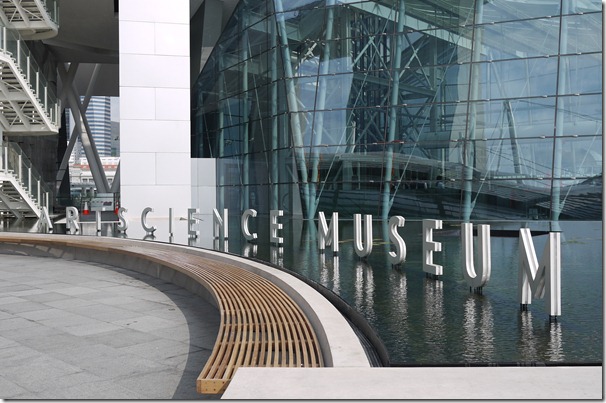

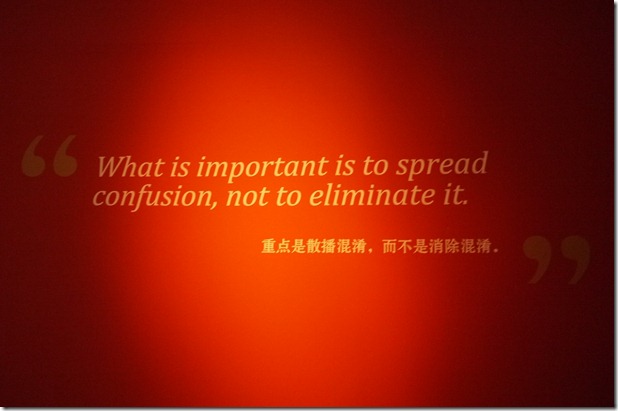






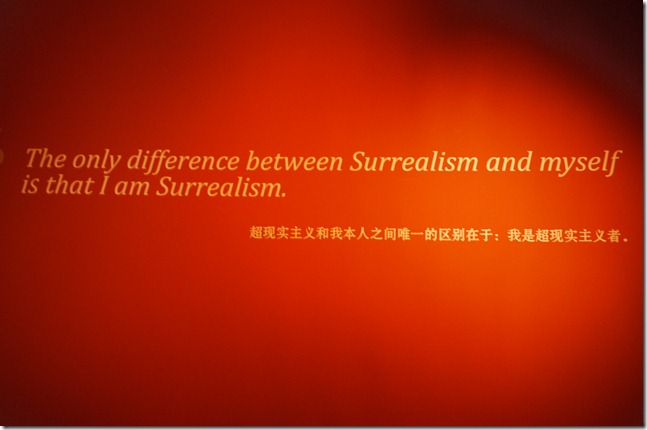



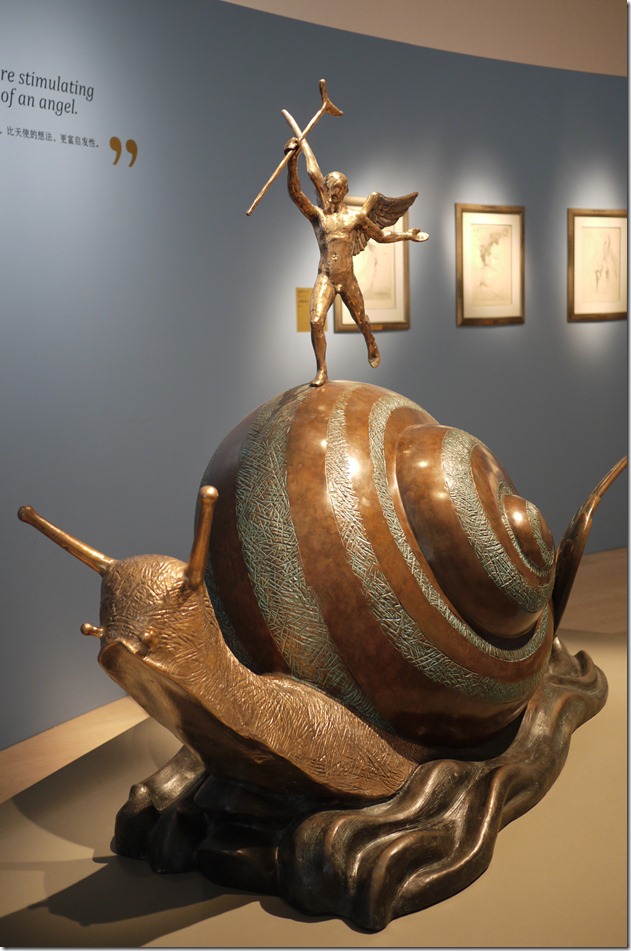


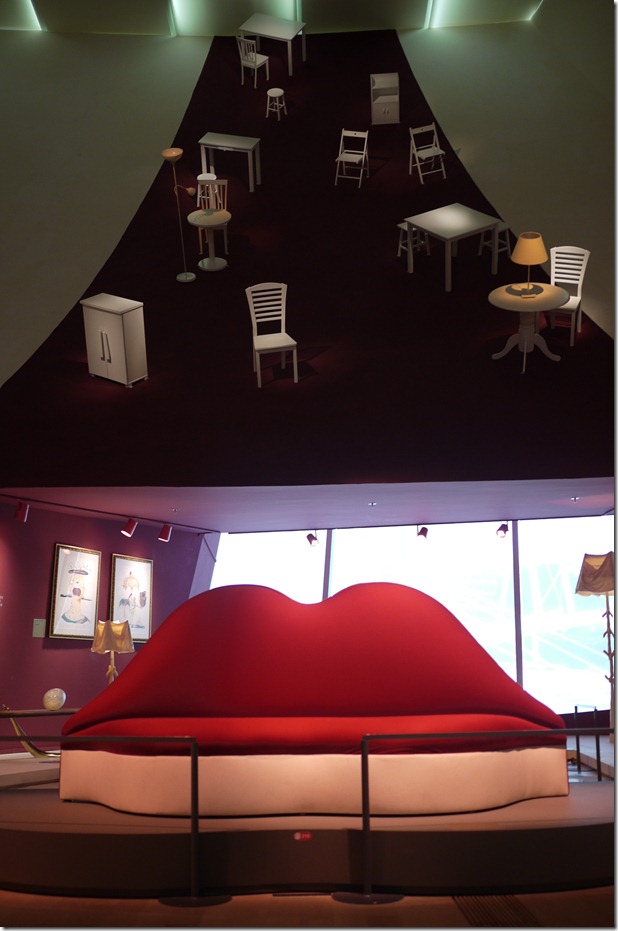




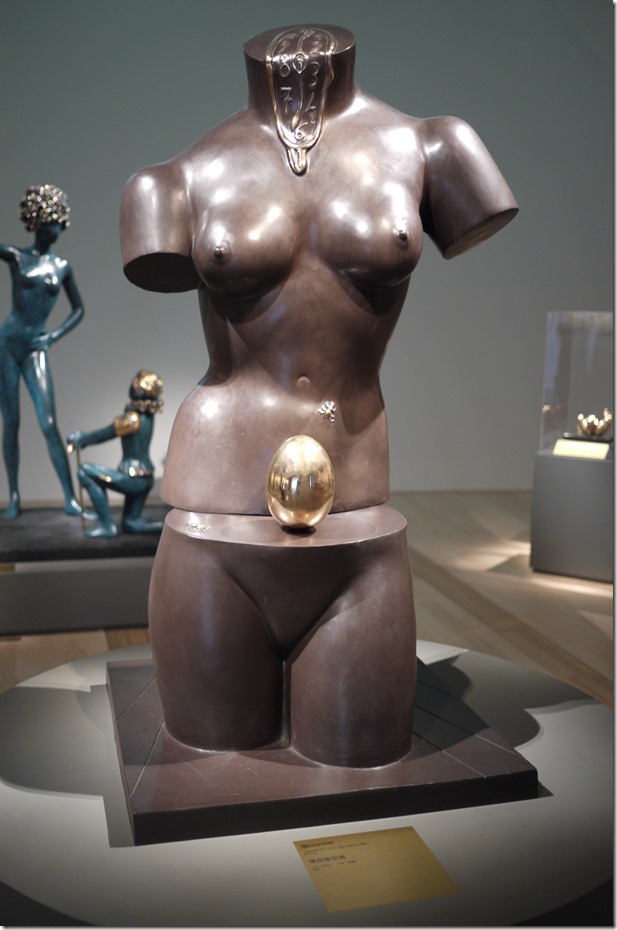
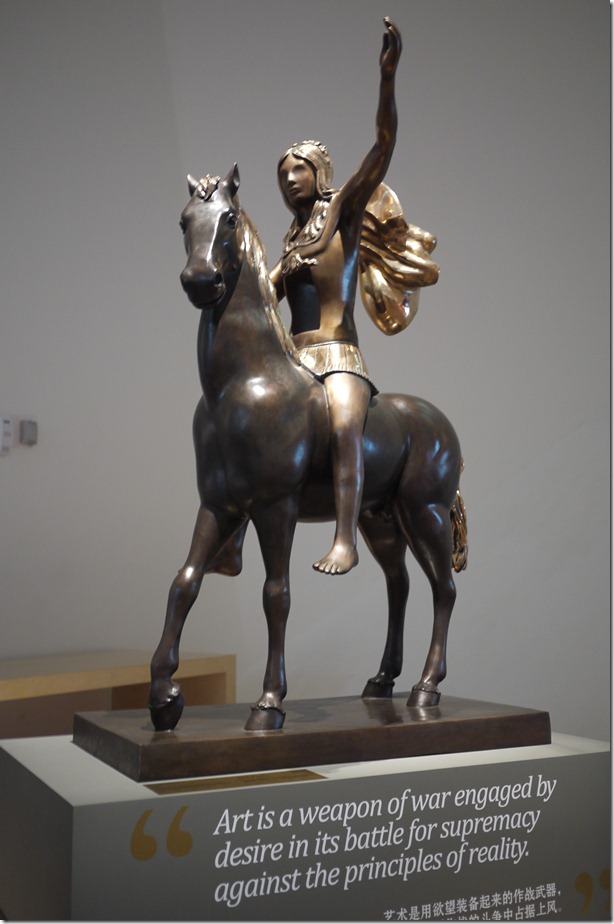

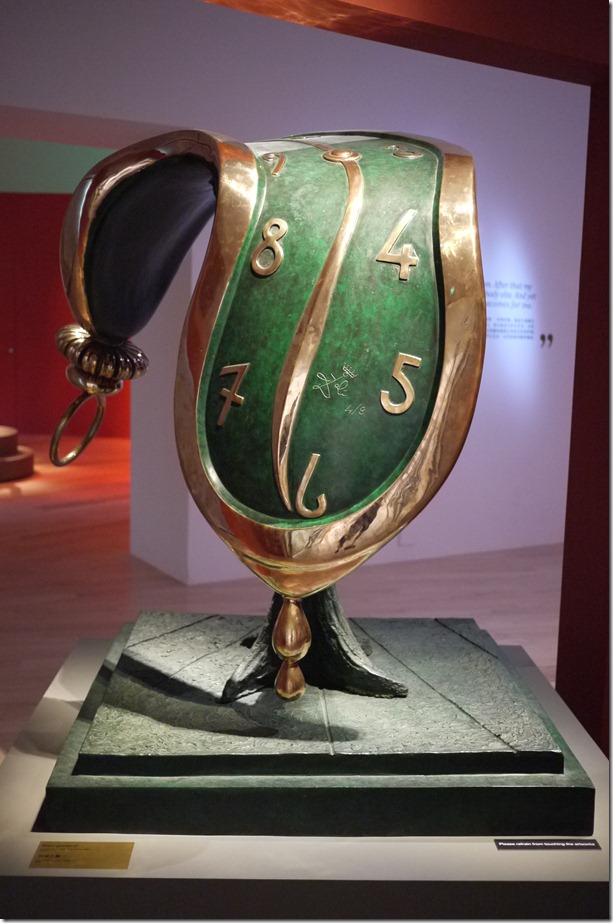





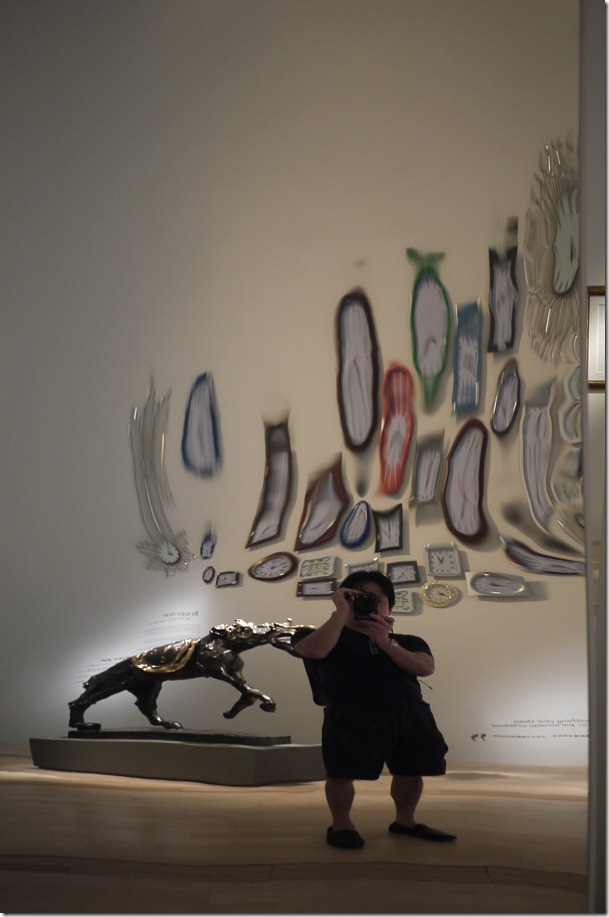


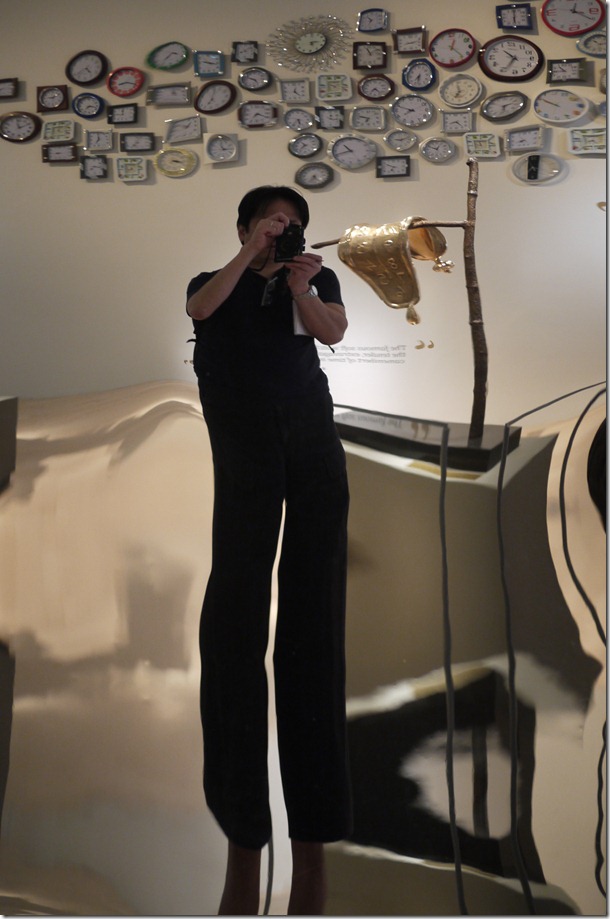



































































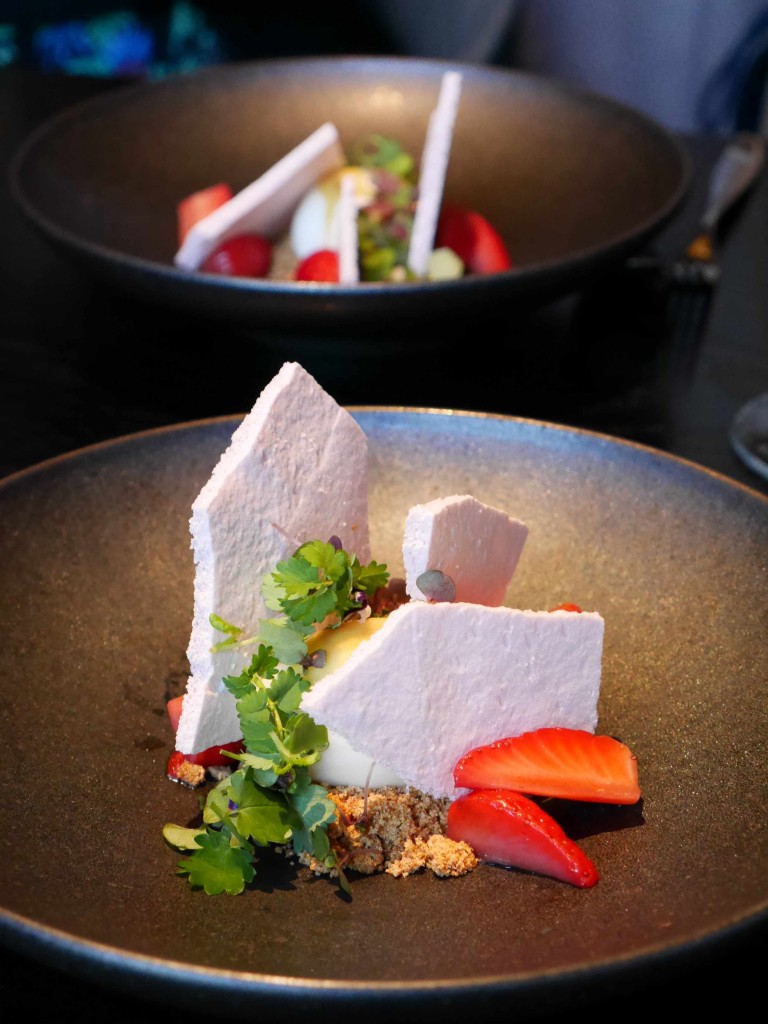



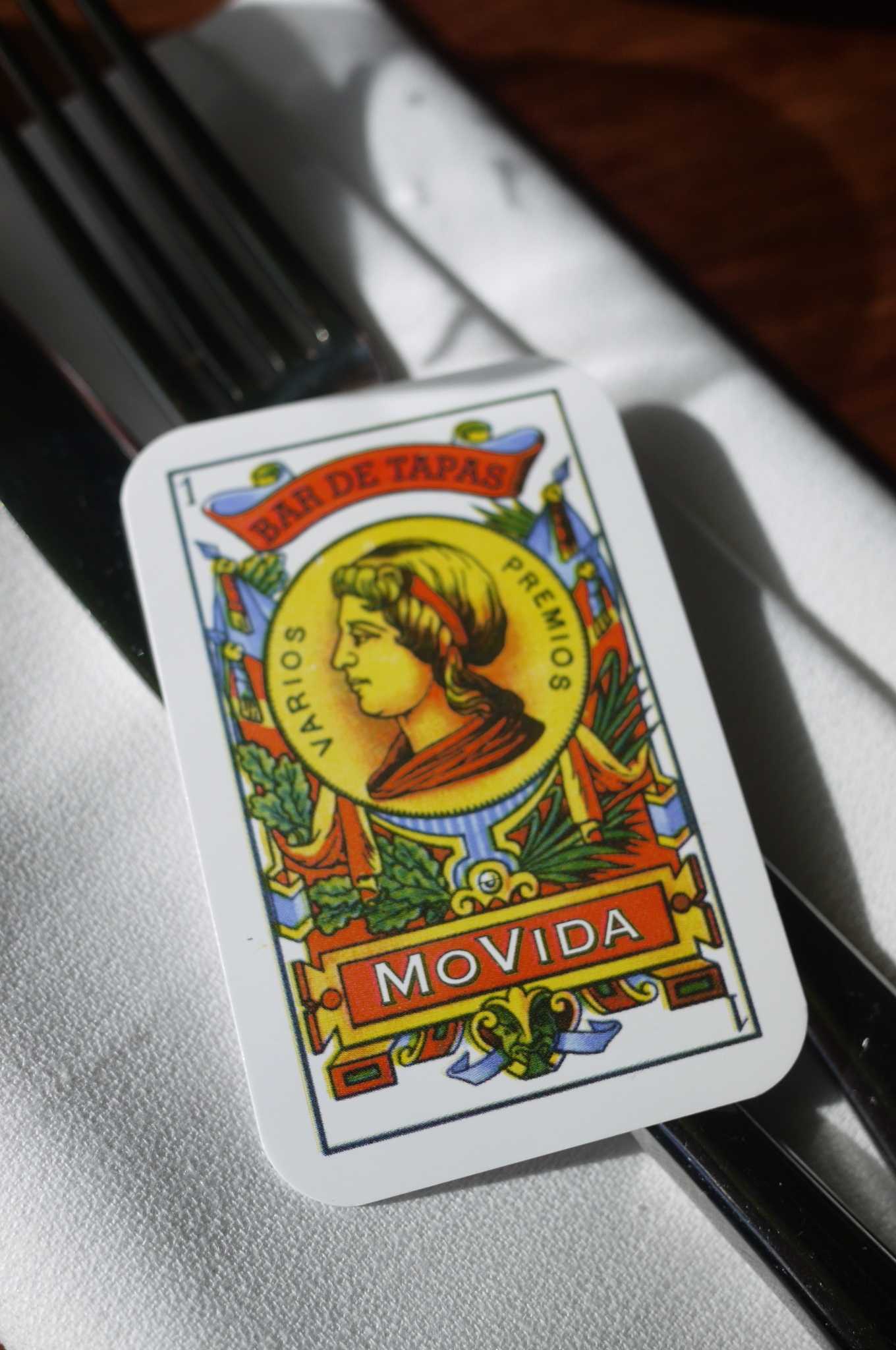









































His quotes are words of wisdom! And the lobster-telephone quote shows his sense of humor too. Those must be his method to madness…
Beautiful! Thanks for sharing.
Interesting and informative. Beautiful photos.
love the quotes!!
if only there was a museum filled with quotes. im in!
Aww, thank you for this, Chopinand! I totally loved this post, and I have so many thoughts on it … At least some of them:
~ “Every morning upon awakening, I experience a supreme pleasure: that of being Salvador Dali… And I ask myself, wonderstruck, what prodigious thing will he do today this Salvador Dali?” ~
Well, *that* is some self-confidence! 😀 The other quotes, though, tell of very deep reflections and insights. My favorite one was the one below the Roman warrior sculpture, that art was a weapon of desire to fight for supremacy against the principals of reality.
So far, I mainly knew some of Dalí’s paintings with the melted clocks, but I had no idea he has made those awesome sculptures as well! My favorite ones are Adam and Eve with the heart-shaped snake (such a cool re-interpretation!), the Man with Butterfly, the dancing Terpsichore, and above all the Woman of Time and the Space Elephant. I also liked the furniture, especially the picture with the pieces of furniture scattered on that concave ground – they look so lost there, but still seem to try to keep up an illusion of meaning with all their heart and courage. Thank you for sharing all these artworks and your thoughs on them!
~~~
I liked the connection you made to other areas of arts: psychoanalysis (which I see as a kind of art, because it deals with deriving meaning from the inconceivable, like when you read a poem) and music. I believe that the human mind functions in a way that it construes meaning and structure(s) everywhere, while we’re surrounded by quite a lot of chaos. If it wouldn’t do that, people would live in paralyzing anxiety all the time. So, whenever a human being perceives something, he immediately puts that object of perception into a category where it seems to fit in a meaningful way. This is usually done within the blink of an eye – too quickly to realize that this process takes place at all. So I believe what surrealistic art does is that is inhibits this immediate categorization, widening the time-space between the act of perception and the act of categorization, and forcing us to look into the gap between the two. When we do that, we get a grasp of chaos, and that leaves us with confusion and a feeling of diffuse discomfort, because it affects our most basic anxieties. So, many people turn away quickly, but some of them get curious and want to look closer and think about what they’ve seen, and usually don’t experience. I think that challenging this looking into the gap holds the potential to teach us a lot about ourselves and how we are and live, and can be a great starting point for widening your mind and understanding that the world is more what we perceive and consider to be “just so”. It takes us out of our day-to-day comfort and ignorance and makes us more aware of the wonders of life, the littleness of human, and the freeing qualities of the arts. But, it can be a little unsettling. 😉
~~~
The architecture in Singapore is absolutely breath-taking! I want to swim in that pool! 😀 (I just wonder: Can you fall out of it? And does the water swamp over and rain on the people on the street below when somebody dabbles too much? ;))
~~~
It’s very interesting what you say about your experiences with having lived and worked in two very different cultures, and that you can’t be both Asian and Australian at a time. I’ve often thought that globalization in the sense of making everything one big soup doesn’t work out (a soup tastes *terrible* if you throw everything you have into it – from cabbage, bananas, fish, rice, bread, milk, wine, flour, to peanuts, tofu, celery, plums, beans, vinegar, etc – eek :?), because there’s not just one truth, but rather different things that are sometimes hard to combine but all have their legitimation on their own. It would leave people totally confused and identity-shattered (not good :(), so it would be much better to embrace cultural diversity and appreciate the differences without being frightened. On that basis, there’ll be still a lot to discover that we have in common.
~~~
You already know that I love your explanation why you blog. “For me, I believe blogging is about sharing moments in time with others, so that hopefully, when I look back at these moments, they awaken my imagination and fuel my emotions.” That’s absolutely it.
Oh, how fantastic! I went to the Dali museum in Paris and loved it – hopefully I can get to this before it leaves (slightly closer than Paris 😛 )
Wow, what an impressive view from the SkyPark Pool!
I went to his exhibition in Melbourne last year, I am still amazed by the craftsmanship with ‘The Royal Heart’, it’s just incredible.
The self-photography is really fun! Like you enter the world of Alice in Wonderland. Thank you for taking us to your trip as well ;-).
You can’t help but stop to ponder a Dali work. They all just make you think and look at the most mundane things in a whole new way. Years ago, I had the chance to visit the Dali museum in St. Petersburg, FL. I highly recommend it. Just fascinating.
Great photos – I love Dali!
great post! and i blog because i want to share my experiences with the world too!…or whoever is interested to read them
Wow. This is an incredibly thorough and insightful post. Thank you so much for sharing. I have to admit I’ve never heard of Dali before, but now I think I have a new topic to google and research. I love the way he views things in different perspectives; it’s such a fantastic exercise for our minds.
Pingback: Salvador Dali
Yes yes!! Blogging is about sharing the moment in time with others and all that you’ve mentioned – think you described it beautifully. and thanks for taking us on a journey with you too on your trip…that pool looks sooo awesome!
I saw his exhibition in Melbourne a few years ago and was fascinated by his way of thinking. He’s a bit of a crazy genius isn’t he? His works really provoke thought but my favourite is the portrait he did of his wife, using spheres to depict her image. It shows his romantic and gentle side. 😉
Love the chair, it’s beautiful. Thanks for sharing this fabio post with us, I feel like I’ve had an adventure from the comfort of my office. Love blogging for that very reason, you can share with everyone.
Love blogging for that very reason, you can share with everyone. 
This is a VERY interesting post!!!
My comment may be a bit unpopular, but I must admit I do not like Dali. I have nothing against surrealism as a movement… I actually like Breton, Magritte and many others, but Dali is too “over the top” for me. He was pure genius nonetheless. I have visited his house/museum in Figueres (Spain) and came out with a headache. I know many of you are probably thinking I do no understand anything about modern art… it may be true. But I have grown up in an artistic environment and not a classic one at that… my dad is a MADI artist and used to be a geometric artist before that… I guess I am more attracted by geometric art (I absolutely adore Kandinsky)… but I also love expressionism, cubism, dadaism and moderism (ohhh Gaudi!!!).
Oops… sorry about that!!! I guess it is just a matter of personal “likes and dislikes”!
BTW… that pool looks AMAZING! I haven’t been in Singapore in almost 5 years… time to go back!!!! <3
I really like the sculpture of Adam and Eve – I find it an interesting deptiction of “Original Sin”, and at the same time I think it’s a lovely example of admiration of the human form. Beautiful photos, and a great post!
I would have to agree that blogging is what ever you feel passionate about. You are lucky to experience both cultures in your life and smart enough to live a lucky one. I loved your photos and the passion you have for art.
This looks like a fantastic exhibition, thanks so much for sharing!
I have also been on vacation that I wasn’t aware of your absence. I thought I had so many posts that I missed here, but just this one. It was great to see you Chopin (from your self-portrait photo)! 😉 Thanks for sharing Dali’s work. I haven’t been in museum for such a long time and I appreciated your pictures – just like I was in the museum. I’m really happy to know that you know why you are blogging. Very clear and I can see you will continue blogging as you know what you want. Looking forward to your future posts!
Beautiful post! Thanks for taking us on this journey. I love the furniture and the clocks the most. Imagine having that at home!
Ah ha! So that’s why you haven’t blogged in awhile.
I agree being Asian and living in Australia, one has to navigate a perception landmine with those back in the motherland, who believe Australia is this land of milk and honey. It is, to some degree, but it is not without its faults and unless you live here, you might not ‘get it’.
Hmmmm, but I wonder if he would have eaten the telephone or sent it back to the kitchen?
Hi tigerfish, I think he is as quirky as he is artistic and surreal!
Hi mac, thanks for dropping by.
Hi Maris, thanks!
Hi Dolly, I wished I had more time to get more pics of his quotes.
Hi Kath, I think he had to be pretty confident and egoistic to come up with some of his works and he was definitely a fighter against reality. Categorisation can limit our perceptions, just like how de Bono talks describes rain falling upon a landscape and the trails of water forming streams and then rivers. We are bound by our life prints unless we can suspend judgment and “look into the gap” like you said to find new ideas and insights about our world. The infinity pool is pretty spectacular, all 150 metres of it. You can’t fall out at the end because there is another safety wall beyond and below the pool and a catchment drain for water that overflows. I might send you some pics behind the wall of the pool.
Multiculturalism in Australia where so many people of different background and heritage is celebrated has definitely made this country richer in many aspects because we practice tolerance and co-operation whilst learning to appreciate the differences and diversity.
Hi Hannah, this exhibition goes on for quite a few months so you will have plenty of time.
Hi Ching, the view of Singapore’s skyline from the pool is nothing short of spectacular!
Hi Dumpling Girl, the Royal Heart is really an intricate web of artistry.
Hi Diana, I did have a bit of fun with those mirrors!
Hi Carolyn, I agree that each piece of work is thought-provoking and fascinating.
Hi Maria, thanks for dropping by.
Hi sugarpuffi, I enjoy reading your posts and the gatherings you have with fellow bloggers. Hope I get to meet some of you guys one day.
Hi Sophia, you will be pretty busy if you’re going to start studying Dali’s works.
Hi vivienne, I’m glad you enjoyed this post.
Hi Jen, I think there could be more than a few ways of interpreting the use of spheres to depict his wife
Hi Anna, I love the furniture too, seems to have a life of their own!
Hi Manu, I think art is subjective and each person may see a piece of work differently. The fact that you got a headache might also mean that you are enjoying Dali too much If you like geometric art, I guess you will also like the art works of MC Escher. He is one of my favourites.
If you like geometric art, I guess you will also like the art works of MC Escher. He is one of my favourites.
Hi JasmyneTea, Adam and Eve is a great work, especially the snake forming a heart shape with its body.
Hi tania, thanks for your comments. I think art gives us an avenue to dream and be imaginative.
Hi 5 Star Foodie, thanks and glad you enjoyed this post.
Hi Nami, I might not have gone to the museum either without Dali’s exhibition. I thoroughly enjoyed all the artworks because they are so thought-provoking.
Hi Corinne, I have also tried to imagine having some of those art works at home, pretty awesome!
Hi Melissa, I agree with your observer vs participant viewpoint about living in Australia. It is definitely easier understand and appreciate the cultural issues of a country by living in it.
Hi InTolerantChef, I think he would have eaten the telephone as long as it’s well cooked and served with some of his favourite condiments and sauces.
Hi Chopinand, I hope you didn’t get me wrong – I’m not against multiculturalism in general, just against some ways it is often understood: as “one” global culture for everybody. I don’t believe that’s possible. The way you describe it – people living next to each other peacefully, and respecting thier own and each other’s cultural heritage – is what I had in mind as a functioning and beneficial realization of multiculturalism.
I’m very much for that: a world that’s growing together, but has enough space for all the differences among cultures and people. We can learn so much from each other then.
I agree a melting pot is always more flavoursome than one-dimensional cooking!
Pingback: Dali m?gstamiausi « Apie Taivan?, Taip?j? ir t.t… :)
Pingback: Thinksnack | Lobster telephone